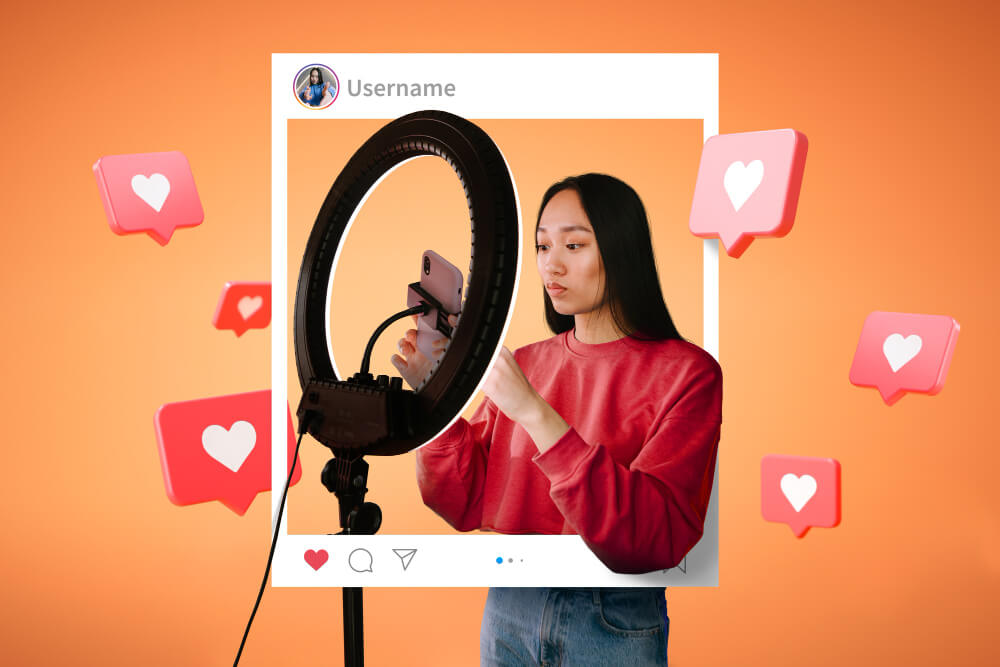
In today’s digital age, social media has become an integral part of our lives, shaping trends, opinions, and consumer behaviors. Among the myriad strategies brands employ to connect with their target audience, influencer marketing stands out as a powerful tool for reaching and engaging with consumers on social platforms. However, the success of influencer marketing campaigns hinges greatly on the selection of the right partners.
In this blog post, we delve into the art and science of finding the perfect influencers for your brand’s social media endeavors. From understanding your brand identity and audience demographics to evaluating influencers’ authenticity and engagement metrics, we’ll explore the crucial steps involved in identifying, vetting, and collaborating with influencers who can authentically represent your brand and resonate with your audience. Join us as we uncover the secrets to navigating the dynamic landscape of influencer marketing on social media and discovering the ideal partners to elevate your brand’s presence and influence online.
Understanding Your Brand and Audience
Before embarking on the journey of influencer marketing, it’s essential to have a clear understanding of your brand identity and the audience you aim to reach. This foundational step lays the groundwork for successful partnerships with influencers who effectively communicate your brand message to the right audience segments.
Defining Your Brand Identity
Outline your brand’s values, mission, and unique selling points.
Identify the tone, aesthetic, and personality that best represent your brand.
Consider what sets your brand apart from competitors and resonates with your target audience.
Identifying Your Target Audience
Conduct market research to understand your audience’s demographics, interests, and behaviors.
Segment your audience based on factors such as age, gender, location, interests, and purchasing habits.
Develop buyer personas to create a detailed profile of your ideal customers, including their pain points, preferences, and motivations.
Aligning Brand Values with Influencers
Seek influencers whose personal brand aligns with your brand’s values and ethos.
Evaluate influencers based on their content themes, messaging, and audience demographics to ensure alignment with your target audience.
Consider whether the influencer’s audience shares characteristics with your ideal customer personas, fostering authenticity and resonance in collaborations.
Read More: The Role of Artificial Intelligence in Digital Marketing Automation
Identifying Potential Influencers
Once you have a clear understanding of your brand identity and target audience, the next step is to identify potential influencers who can amplify your message and connect with your audience on social media. In today’s diverse influencer landscape, it’s crucial to explore various types of influencers and leverage tools to find the right partners for your brand.
Types of Influencers
- Micro-Influencers: These influencers have smaller but highly engaged audiences within specific niches. They often offer higher levels of authenticity and influence within their communities.
- Macro-Influencers: With larger followings ranging from tens of thousands to millions, macro-influencers appeal to broader audiences. They can generate significant reach and exposure for brands.
- Mega-Influencers: Celebrities, industry leaders, and public figures fall into this category, boasting massive followings across multiple platforms. Collaborating with mega-influencers can yield widespread brand visibility, although it may come at a higher cost.
Tools and Platforms for Influencer Discovery
- Social Media Platforms: Utilize built-in search features on platforms like Instagram, YouTube, TikTok, and Twitter to discover influencers relevant to your niche. Explore hashtags, and geotags, and explore pages to find potential partners.
- Influencer Marketing Platforms: Platforms like Influencity, AspireIQ, and Upfluence offer databases of influencers across various niches, allowing brands to search, filter, and connect with influencers based on specific criteria.
- Google Search and Social Listening Tools: Conduct Google searches and use social listening tools like Mention or Brandwatch to identify influencers who are already discussing topics relevant to your brand or industry.
Qualities to Look for in Influencers
- Relevance: Ensure that the influencer’s content aligns with your brand’s niche, industry, or target audience. Look for influencers whose interests and expertise complement your brand’s offerings.
- Engagement: Evaluate an influencer’s engagement metrics, including likes, comments, shares, and overall interaction with their audience. High engagement indicates an active and dedicated fan base.
- Authenticity: Seek influencers who authentically connect with their followers and maintain genuine relationships. Authenticity fosters trust and credibility, enhancing the effectiveness of influencer collaborations.
Once you’ve identified potential influencers for your brand, it’s essential to thoroughly evaluate them to ensure they align with your campaign goals, audience demographics, and brand values. By scrutinizing key metrics and assessing the authenticity of influencers, you can make informed decisions about collaboration and maximize the impact of your influencer marketing efforts.
Engagement Metrics
- Likes, Comments, Shares: Analyze the level of engagement on an influencer’s posts to gauge their ability to captivate and resonate with their audience. High levels of interaction indicate an active and engaged following.
- Engagement Rate: Calculate the engagement rate by dividing total engagement (likes, comments, shares) by the number of followers and multiplying by 100. A higher engagement rate signifies a more engaged audience relative to the influencer’s follower count.
Audience Demographics and Authenticity
- Audience Insights: Utilize available analytics tools or request audience demographics from influencers to gain insights into their follower demographics, including age, gender, location, and interests. Ensure their audience aligns with your target demographic.
- Audience Authenticity: Assess the authenticity of an influencer’s audience by analyzing the quality of comments, diversity of followers, and consistency of engagement patterns. Beware of influencers with a high number of fake or inactive followers, as it can undermine campaign effectiveness.
Content Quality and Relevance
- Content Alignment: Review the influencer’s previous content to assess its relevance to your brand and campaign objectives. Look for alignment in tone, messaging, and visual style to ensure seamless integration with your brand’s aesthetic and values.
- Content Consistency: Evaluate the frequency and consistency of content creation to determine the influencer’s reliability and dedication to their audience. Consistent posting demonstrates professionalism and commitment to maintaining audience engagement.
Brand Affiliations and Reputation
- Previous Brand Collaborations: Research the influencer’s history of brand partnerships to identify any conflicts of interest or potential associations that may impact your brand’s image.
- Reputation and Ethics: Assess the influencer’s reputation within the industry and their adherence to ethical standards and disclosure guidelines. Choose influencers known for transparency and authenticity in their collaborations.
Long-Term Potential
- Relationship Building: Consider the potential for long-term partnerships beyond individual campaigns. Invest in influencers who demonstrate a genuine interest in building sustainable relationships with brands and fostering ongoing engagement with their audience.
- Brand Alignment: Evaluate whether the influencer’s values and interests align with your brand’s long-term objectives and future initiatives. Seek partnerships that offer mutual benefits and opportunities for growth.
Building Relationships with Influencers
Building strong relationships with influencers is essential for the success of influencer marketing campaigns. Cultivating genuine connections fosters trust, enhances collaboration, and maximizes the impact of influencer partnerships. Here are key steps to effectively build and maintain relationships with influencers:
Approaching Influencers Professionally
- Personalize Your Outreach: Tailor your communication to each influencer, demonstrating genuine interest in their content and audience.
- Be Clear and Concise: Communicate your brand’s values, campaign objectives, and expectations for collaboration.
- Respect Their Time: Acknowledge the influencer’s busy schedule and offer flexibility in timing and deliverables.
Negotiating Partnerships and Compensation
- Transparent Communication: Discuss partnership terms, compensation, and deliverables openly and honestly.
- Offer Value: Provide influencers with compelling incentives, such as product samples, exclusive experiences, or monetary compensation, that align with their interests and audience preferences.
- Negotiate Fairly: Respect the influencer’s expertise and negotiate mutually beneficial terms that recognize their value and contribution to the campaign.
Crafting Effective Collaboration Agreements
- Define Expectations: Clearly outline campaign objectives, content requirements, posting schedules, and usage rights in a written agreement.
- Set Clear Guidelines: Provide detailed guidelines on brand messaging, visual aesthetics, and disclosure requirements to ensure consistency and compliance.
- Establish Communication Channels: Designate a point of contact and establish open lines of communication to address any questions, concerns, or issues that may arise during the collaboration.
Fostering Collaboration and Creativity
- Encourage Creative Freedom: Empower influencers to leverage their creativity and authenticity to develop content that resonates with their audience while aligning with your brand’s objectives.
- Collaborate on Content Ideas: Brainstorm content concepts and campaign themes collaboratively to leverage the influencer’s unique perspective and expertise.
- Showcase Mutual Benefits: Highlight the benefits of collaboration for both parties, emphasizing the value of building a long-term partnership based on trust and mutual respect.
Providing Ongoing Support and Recognition
- Show Appreciation: Express gratitude for the influencer’s contributions and efforts throughout the collaboration.
- Amplify Their Voice: Share influencer-generated content on your brand’s social media channels and website to amplify their reach and visibility.
- Provide Feedback and Recognition: Offer constructive feedback and recognition for exceptional performance, fostering a positive working relationship and encouraging future collaborations.
Read More: The Rise of TikTok: How to Use the Platform for Marketing
Monitoring and Measuring Campaign Performance
Monitoring and measuring the performance of influencer marketing campaigns is crucial for assessing their effectiveness, optimizing strategies, and achieving desired outcomes. By leveraging key metrics and analytics tools, brands can gain valuable insights into campaign performance and make data-driven decisions to enhance future initiatives. Here’s how to effectively monitor and measure the performance of influencer marketing campaigns:
Setting Clear Objectives and Key Performance Indicators (KPIs)
- Define Specific Goals: Establish clear and measurable objectives for your influencer marketing campaign, such as increasing brand awareness, driving website traffic, or boosting sales.
- Identify Relevant KPIs: Determine key performance indicators that align with your campaign goals, such as engagement rate, reach, click-through rate (CTR), conversion rate, and return on investment (ROI).
Tracking Metrics and Analytics
- Engagement Metrics: Monitor the level of engagement generated by influencer content, including likes, comments, shares, and saves. Analyze engagement rates to gauge audience interaction and sentiment.
- Reach and Impressions: Track the reach and impressions of influencer posts to assess the campaign’s exposure and visibility among the target audience.
- Website Traffic: Use UTM parameters and tracking links to measure the impact of influencer-driven traffic on your website. Monitor metrics such as referral traffic, session duration, and conversion behavior.
- Conversion Tracking: Implement conversion tracking tools, such as Google Analytics or platform-specific tracking pixels, to attribute conversions and track the ROI of influencer-driven initiatives.
Assessing ROI and Adjusting Strategies
- Calculate ROI: Evaluate the return on investment by comparing the campaign’s total costs (e.g., influencer fees, production expenses) against the generated revenue or other desired outcomes (e.g., leads generated, products sold).
- Analyze Cost per Acquisition (CPA): Determine the cost per acquisition for each desired action, such as website visits, email sign-ups, or purchases, to assess the campaign’s efficiency and profitability.
- Iterate and Optimize: Use insights gathered from campaign performance analysis to identify strengths, weaknesses, and areas for improvement. Adjust strategies, messaging, or targeting parameters accordingly to optimize future campaigns for better results.
Utilizing Analytics Tools and Platforms
- Social Media Analytics: Leverage built-in analytics tools provided by social media platforms, such as Instagram Insights, YouTube Analytics, or TikTok Analytics, to track performance metrics and audience demographics.
- Third-Party Analytics Tools: Explore third-party analytics platforms, such as Hootsuite, Sprout Social, or Buffer, to gain deeper insights into campaign performance, competitor analysis, and industry benchmarks.
Reporting and Communication
- Generate Comprehensive Reports: Compile campaign performance data into comprehensive reports that provide insights into key metrics, trends, and actionable recommendations.
- Communicate Results Effectively: Share campaign performance reports with stakeholders, including internal teams, clients, or influencer partners, to facilitate transparent communication and collaboration.
- Celebrate Successes and Learn from Challenges: Acknowledge successful outcomes and achievements while also identifying lessons learned and areas for improvement to inform future strategies and decision-making.
Challenges and Pitfalls to Avoid
While influencer marketing offers numerous benefits, it also presents challenges and pitfalls that brands must navigate to ensure successful campaigns. By being aware of these challenges and implementing proactive strategies, brands can mitigate risks and maximize the effectiveness of their influencer partnerships. Here are some common challenges and pitfalls to avoid:
Fraudulent Influencer Practices
- Fake Followers and Engagement: Beware of influencers who artificially inflate their follower count or engagement metrics through fraudulent means, such as purchasing followers or using engagement pods.
- Bot Activity: Monitor for signs of bot activity, such as sudden spikes in follower count or engagement that are inconsistent with historical patterns.
- Vetting Influencers: Conduct thorough due diligence when selecting influencers, verifying their authenticity, and scrutinizing their audience demographics and engagement metrics.
Overlooking Audience Relevance
- Mismatched Audiences: Avoid partnering with influencers whose audience demographics, interests, or values do not align with your brand’s target audience. Ensure relevance and resonance to maximize the impact of influencer collaborations.
- One-size-fits-all approach: Resist the temptation to work with influencers solely based on their follower count or popularity. Instead, prioritize relevance and authenticity to establish genuine connections with your target audience.
Failing to Establish Clear Communication
- Misaligned Expectations: Communicate campaign objectives, expectations, and deliverables with influencers to avoid misunderstandings or misinterpretations.
- Lack of Transparency: Foster open and transparent communication channels with influencers regarding compensation, brand guidelines, and disclosure requirements. Encourage honesty and integrity in all interactions.
Inconsistent Brand Messaging
- Diluted Brand Identity: Ensure consistency in brand messaging and visual aesthetics across influencer collaborations to maintain brand integrity and coherence.
- Off-Brand Content: Monitor influencer-generated content to ensure it aligns with your brand’s values, tone, and guidelines. Provide clear direction and feedback to steer content in the desired direction.
Ignoring Legal and Regulatory Compliance
- FTC Guidelines: Familiarize yourself with relevant advertising and disclosure guidelines, such as those outlined by the Federal Trade Commission (FTC), and ensure compliance with mandatory disclosure requirements for sponsored content.
- Data Privacy Regulations: Adhere to data privacy regulations, such as the General Data Protection Regulation (GDPR) in the European Union, when collecting and processing personal data in influencer marketing campaigns.
Limited Measurement and ROI Tracking
- Inadequate Metrics: Avoid relying solely on vanity metrics, such as follower count or likes, to measure campaign success. Instead, track meaningful metrics, such as engagement rate, click-through rate, conversion rate, and return on investment (ROI).
- Lack of Attribution Modeling: Implement robust attribution modeling techniques to accurately attribute conversions and measure the impact of influencer-driven initiatives across the customer journey.
Future Trends in Influencer Marketing
The evolving digital landscape signals transformative changes for influencer marketing, driven by shifting consumer behaviors. Brands must stay ahead of the curve and adapt to emerging trends to maintain relevance and maximize the impact of their influencer partnerships. Here are some future trends shaping the landscape of influencer marketing:
Rise of Niche Influencers and Micro-Influencers
Brands increasingly value niche and micro-influencers with engaged audiences in specific interest areas or communities.
Niche influencers offer authenticity, credibility, and deeper connections with their followers, making them ideal partners for brands seeking to target specific demographics or niche markets.
Emergence of New Social Media Platforms
As social media platforms evolve and new ones emerge, brands must adapt influencer marketing strategies.
Platforms such as TikTok, Clubhouse, and emerging platforms in the metaverse present opportunities for innovative content creation and engagement with Gen Z and younger demographics.
Integration of Influencer Marketing with E-commerce and Augmented Reality
Brands innovate by integrating influencer marketing with e-commerce, leveraging influencers to drive direct sales from social media.
Augmented reality (AR) technology enhances influencer campaigns, letting followers try products virtually and engage with interactive content.
Authenticity and Transparency Remain Paramount
As influencer marketing matures, authenticity and transparency continue to be critical factors in building trust and credibility with audiences.
Brands and influencers must maintain transparency in their partnerships, clearly disclosing sponsored content, paid collaborations, and brand affiliations to comply with regulatory requirements and foster trust among followers.
Long-Term Partnerships and Brand Ambassadors
Brands are shifting towards long-term partnerships and ambassador programs with influencers, fostering deeper relationships and loyalty over time.
By investing in ongoing collaborations, brands can leverage influencer expertise, creativity, and authenticity to create cohesive brand narratives and drive sustained engagement with their audience.
Data-Driven Influencer Selection and Performance Measurement
Brands are increasingly leveraging data analytics and machine learning algorithms to identify and evaluate influencers based on performance metrics, audience insights, and predictive modeling.
Data-driven approaches enable brands to make informed decisions, optimize influencer selection, and measure campaign effectiveness more accurately, ultimately driving better results and ROI.
Conclusion
Influencer marketing has emerged as a powerful strategy for brands to connect with their target audience, drive engagement, and build brand awareness in the dynamic world of social media. As we’ve explored in this blog post, finding the right influencers is essential for the success of influencer marketing campaigns. By understanding your brand identity, identifying your target audience, and carefully vetting potential partners, you can align your brand with influencers who authentically resonate with your audience and embody your brand values.
As the influencer marketing landscape continues to evolve, brands must stay ahead of emerging trends and adapt their strategies to remain relevant. From the rise of niche and micro-influencers to integrating influencer marketing with e-commerce and augmented reality, opportunities abound for brands to innovate and engage audiences in meaningful ways.






